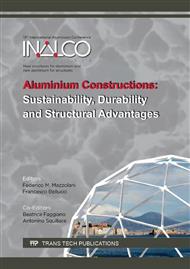[1]
European Committee for Standardisation, 'Eurocode 3: Design of Steel Structures. ', ENV 1993-1. 1, Brussels, Belgium, (2005).
Google Scholar
[2]
European Committee for Standardisation, 'Eurocode 9: Design of Aluminium structures, ENV 1999-1. 1, Brussels, Belgium, (2007).
Google Scholar
[3]
Moen L, Hopperstad OS, Langseth M. Rotational capacity of aluminium beams subjected to non-uniform bending, - Part I: Experiments. Journal of Structural Engineering ASCE 1999; 125(8): 910–20.
DOI: 10.1061/(asce)0733-9445(1999)125:8(910)
Google Scholar
[4]
Faella C., Mazzolani F.M., Piluso V., Rizzano G. Local buckling of aluminium members: testing and classification,. Journal of Structural Engineering, ASCE 2000; 126 (3): 353–60.
DOI: 10.1061/(asce)0733-9445(2000)126:3(353)
Google Scholar
[5]
Lay, M. G., and Galambos, T. V. (1967). 'Inelastic beams under moment gradient. ', J. Struct. Div., ASCE, 93(1), 381–399.
DOI: 10.1061/jsdeag.0001589
Google Scholar
[6]
Lukey, A. F., and Adams, P. F. (1969). 'Rotation capacity of wide-flange beams under moment gradient. ', J. Struct. Div., ASCE, 96(6), 1173– 1188.
DOI: 10.1061/jsdeag.0002290
Google Scholar
[7]
ABAQUS. User's Manual: Volume III: Materials, (2010).
Google Scholar
[8]
ABAQUS. User's Manual: Volume IV: Elements, (2010).
Google Scholar
[9]
Opheim, B. S. (1996). 'Bending of thin-walled aluminum extrusions. ', Dr. ing. thesis, Div. of Struct. Engrg., Norwegian University of Science and Technology, Trondheim, Norway.
Google Scholar
[10]
Moen L, De Matteis G, Hopperstad OS, Langseth M, Landolfo R, Mazzolani FM. Rotational capacity of aluminium beams subjected to non-uniform bending—Part II: Numerical model. Journal of Structural Engineering ASCE 1999; 125(8): 921–9.
DOI: 10.1061/(asce)0733-9445(1999)125:8(921)
Google Scholar
[11]
De Matteis G., Landolfo R., Manganiello M., Mazzolani F.M., Inelastic Behaviour of I-shaped aluminium beams: numerical analysis and cross-sectional classification, Computer & Structures, Vol. 82, pp.2157-2171.
DOI: 10.1016/j.compstruc.2004.03.071
Google Scholar
[12]
Tryland T., Hopperstad O.S., Langseth M. Finite-Element Modeling of Beams under Concentrated Loading, Journal of Structural Engineering, ASCE, Vol. 127, Issue 2, (2001).
DOI: 10.1061/(asce)0733-9445(2001)127:2(176)
Google Scholar
[13]
Su M-N; Young B., Gardner L. Continuous Beams of Aluminum Alloy Tubular Cross Sections. I: Tests and FE Model Validation, Journal of Structural Engineering, ASCE, Vol. 141 Issue 9, (2015).
DOI: 10.1061/(asce)st.1943-541x.0001214
Google Scholar
[14]
Su M-N; Young B., Gardner L. Continuous Beams of Aluminum Alloy Tubular Cross Sections. II: Parametric Study and Design, Journal of Structural Engineering, ASCE, Vol. 141 Issue 9, (2015).
DOI: 10.1061/(asce)st.1943-541x.0001215
Google Scholar
[15]
De Matteis G, Moen L, Hopperstad OS, Langseth M, Landolfo R, Mazzolani FM. Cross-sectional classification for aluminium beams—parametric study. J Struct Eng ASCE 2001; 127(3): 271–9.
DOI: 10.1061/(asce)0733-9445(2001)127:3(271)
Google Scholar
[16]
Mazzolani F. M., Piluso V. Evaluation of the rotational capacity of steel beams and beam-columns. In: 1st Cost C1 Workshop, Strasbourg, France, (1992).
Google Scholar
[17]
Kemp, A. R. 'Factors affecting the rotation capacity of plastically designed members. ', The Struct. Engr., London, 64B(2), 28–35, (1986).
Google Scholar
[18]
Kato, B. 'Rotation capacity of steel members subject to local buckling. ', Proc., 9th World Conf. on Earthquake Engrg., Vol. IV, 115–120, (1989).
Google Scholar
[19]
Hopperstad, O.S., Modeling of cyclic plasticity with application to steel and aluminium structures, Dr. Ing. Thesis, Div. of Struct. Engrg., Institute of Technology, Trondheim, Norway.
Google Scholar
[20]
Mazzolani FM. Aluminium alloy structures. 2nd ed. London (UK): Chapman & Hall; (1995).
Google Scholar
[21]
Castaldo P., Nastri E. Piluso V. "Evaluation of Rotation Capacity of RHS Aluminium Alloy Beams by FEM Simulation: Temper T4, Incalco2016, Napoli, 21-23 September (2016).
DOI: 10.4028/www.scientific.net/kem.710.288
Google Scholar
[22]
Castaldo P., Nastri E. Piluso V. "Evaluation of Rotation Capacity of RHS Aluminium Alloy Beams by FEM Simulation: Temper T6, Incalco2016, Napoli, 21-23 September (2016).
DOI: 10.4028/www.scientific.net/kem.710.281
Google Scholar
[23]
Math Works Inc. MATLAB-High Performance Numeric Computation and Visualization Software. User's Guide. Natick: MA, USA, (1997).
Google Scholar


